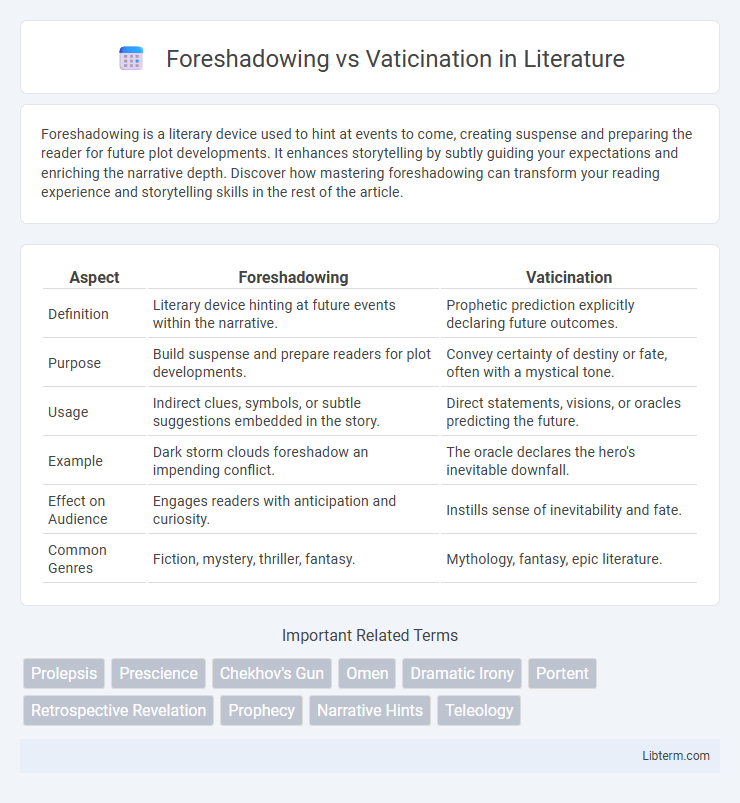Foreshadowing is a literary device used to hint at events to come, creating suspense and preparing the reader for future plot developments. It enhances storytelling by subtly guiding your expectations and enriching the narrative depth. Discover how mastering foreshadowing can transform your reading experience and storytelling skills in the rest of the article.
Table of Comparison
| Aspect | Foreshadowing | Vaticination |
|---|---|---|
| Definition | Literary device hinting at future events within the narrative. | Prophetic prediction explicitly declaring future outcomes. |
| Purpose | Build suspense and prepare readers for plot developments. | Convey certainty of destiny or fate, often with a mystical tone. |
| Usage | Indirect clues, symbols, or subtle suggestions embedded in the story. | Direct statements, visions, or oracles predicting the future. |
| Example | Dark storm clouds foreshadow an impending conflict. | The oracle declares the hero's inevitable downfall. |
| Effect on Audience | Engages readers with anticipation and curiosity. | Instills sense of inevitability and fate. |
| Common Genres | Fiction, mystery, thriller, fantasy. | Mythology, fantasy, epic literature. |
Understanding Foreshadowing: Definition and Purpose
Foreshadowing is a literary device used to hint at future events or outcomes in a story, creating anticipation and enhancing narrative cohesion. It functions by embedding subtle clues or symbols that prepare readers emotionally and intellectually, enriching their engagement and comprehension. Unlike vaticination, which involves explicit prediction or prophecy, foreshadowing operates through implication, maintaining suspense while guiding the plot's development.
Vaticination Explained: Origins and Meaning
Vaticination refers to the act of predicting or prophesying future events, rooted in ancient traditions of oracular and prophetic declarations. The term originates from the Latin "vaticinari," meaning to prophesy or foretell, often associated with prophetic figures in history who conveyed divine or mystical insights about what is to come. Unlike foreshadowing, which is a literary device hinting at future occurrences within a narrative, vaticination encompasses a broader, often spiritual or mystical anticipation of future realities.
Key Differences Between Foreshadowing and Vaticination
Foreshadowing is a literary device used by authors to hint at future events within a narrative, enhancing suspense and thematic depth. Vaticination refers to the act of prophetic prediction or foretelling future occurrences, often relying on intuition or supernatural insight rather than narrative technique. The key difference lies in foreshadowing's function as a crafted storytelling element, whereas vaticination involves genuine or purported foresight into future realities.
Historical Contexts of Foreshadowing and Vaticination
Foreshadowing originates from literary and theatrical traditions, where it serves as a narrative device to hint at future events, enhancing the plot's tension and cohesion. Vaticination, rooted in ancient religious and cultural practices, involves prophetic declarations believed to predict future occurrences based on divine inspiration or supernatural insight. Historical contexts show foreshadowing evolving primarily within storytelling and artistic expression, while vaticination was closely tied to oracles, seers, and rituals in civilizations such as ancient Greece, Rome, and Mesopotamia.
Literary Examples of Effective Foreshadowing
Foreshadowing in literature often appears in works like Shakespeare's "Macbeth," where the witches' prophecies subtly hint at Macbeth's tragic downfall, creating a tense atmosphere. In Edgar Allan Poe's "The Masque of the Red Death," symbolic details such as the ominous clock effectively foreshadow the inescapability of death. Unlike vaticination, which explicitly predicts future events, foreshadowing relies on indirect clues to build suspense and thematic depth.
Instances of Vaticination in Classic Literature
Instances of vaticination in classic literature often appear as prophetic visions or divinations, such as Cassandra's doom-laden predictions in Homer's "Iliad" and the witches' cryptic forecasts in Shakespeare's "Macbeth." These vaticinations serve to influence plot development by forewarning characters and readers of impending fate or tragedy without explicitly revealing plot outcomes. Unlike foreshadowing, which subtly hints at future events, vaticination explicitly articulates destiny, often invoking supernatural or mystical authority.
Techniques for Subtle Foreshadowing in Storytelling
Subtle foreshadowing techniques involve planting indirect clues through symbolism, dialogue, or environmental details that hint at future plot developments without revealing explicit outcomes. Effective use of imagery and metaphor enhances the reader's anticipation and engagement while maintaining narrative suspense. Contrasting with vaticination, which directly predicts or foretells events, foreshadowing relies on nuanced, often ambiguous signals to enrich storytelling depth.
Prophecy vs. Prediction: The Role of Vaticination
Vaticination involves the practice of foretelling future events through prophecy, often grounded in spiritual or mystical insight, distinguishing it from prediction, which relies on empirical data and logical analysis. The role of vaticination in prophecy emphasizes an authoritative, sometimes divine, revelation of future occurrences, setting it apart from the probabilistic nature of predictive models. Understanding the differences between foreshadowing, as a literary device hinting at outcomes, and vaticination, as a solemn declaration of destiny, clarifies how humanity interprets and conveys knowledge about the future.
Impact on Readers: Psychological Effects of Both Devices
Foreshadowing creates suspense and anticipation by subtly hinting at future events, which engages readers' curiosity and primes their expectations, often heightening emotional investment in the narrative. Vaticination, or explicit prophecy, can evoke a sense of inevitability and fatalism, influencing readers' psychological response by creating tension between free will and destiny. Both devices manipulate readers' cognitive and emotional states, but foreshadowing fosters active prediction while vaticination imposes a predetermined outcome.
Choosing the Right Narrative Tool: Foreshadowing or Vaticination?
Foreshadowing subtly hints at future events through clues woven into the narrative, creating suspense and preparing the reader for upcoming twists. Vaticination involves explicit predictions or prophecies that shape the story's direction and character decisions, often adding a mystical or inevitable tone. Choosing the right narrative tool depends on whether the author aims to build gradual anticipation with foreshadowing or drive the plot with clear, impactful forecast using vaticination.
Foreshadowing Infographic

 libterm.com
libterm.com